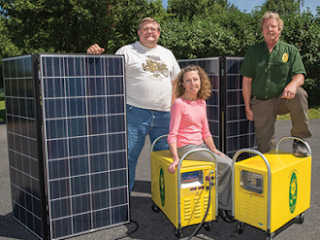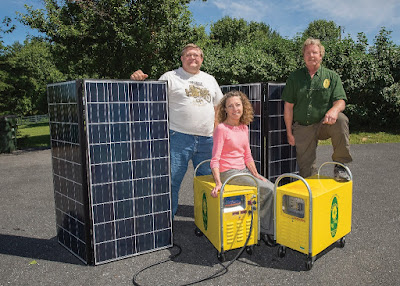Please see the
original publication of this story written by Jessica Sabbath for the July 2016 issue of
Virginia Business Magazine.
 |
The three-person team behind SUNRNR of Virginia Inc., Alan Mattichak,
Jenny French and Scott French. Photo by Mark Rhodes |
In 2008, the founders of SUNRNR of Virginia Inc. began a business in the Shenandoah Valley selling portable, solar-powered generators.
The three executives believed Americans’ growing appetite for clean energy would fuel demand for the generators, which can be used as backup power or as off-grid energy sources.
What the founders didn’t foresee at first was the product’s potential market abroad — particularly on islands or in rural areas where power sources can be unpredictable.
“It’s not that Africa is necessarily looking for green products, but they just need power,” says Jenny French, president of SUNRNR, who leads the business with her husband, Scott, and Alan Mattichak, the inventor of the generators.
Today, the Shenandoah-based company sells generators in countries such as Angola, Ghana, Morocco and Japan. In the Republic of Palau, an island nation in the western Pacific Ocean, the generators are used to power circulation pumps for a fish hatchery. Last year, the company’s generators arrived in the Bahamas just days before Hurricane Joaquin struck. One generator was sent to power a health clinic in a region that had been without power for seven days.
French has used a range of local, state and federal export-assistance programs to build overseas sales for SUNRNR. She has even served on an exporters roundtable at the White House.
All along the way, she’s received help from the International Trade division of the Virginia Economic Development Partnership (VEDP), including a recent grant she used for a trade mission to the Canary Islands and the translation of company documents into Spanish.
Business leaders and government officials believe thousands of Virginia companies also could find potential markets abroad — a move which could be particularly helpful to the state economy in the face of federal budget cuts.
“We cannot make ourselves as vulnerable as we were four or five years ago when we lost about $9.8 billion in direct spending from the Department of Defense,” Gov. Terry McAuliffe said during a May speech to the Virginia International Business Council in Richmond. “We’ve got to become less reliant [on federal spending], and we can only do that through international trade.”
And so the commonwealth is putting an emphasis on developing exports with new programs, additional funding and the creation of an entity dedicated to international trade — the Virginia International Trade Corp. (VITC).
A new focus on trade
For years, Virginia’s business community has sought ways to increase exporting opportunities. “We have been looking at international trade as an important feature of transitioning into a new Virginia economy,” says Barry DuVal, president and CEO of the Richmond-based Virginia Chamber of Commerce. “We recognize that 95 percent of the world’s population lives outside the U.S., and providing more tools for businesses to export their products and services will provide more opportunities in the world market.”
VEDP’s International Trade division now houses Virginia’s export-assistance programs, which have received rave reviews from many companies. “I haven’t run into another government organization that acts more like a consulting firm than VEDP,” says Joe Fluet, CEO of Momentum Aerospace Group, a firm that provides aerial surveillance to the U.S. government. The company recently expanded internationally, exporting to the United Arab Emirates, the Philippines, Canada, NATO and the United Nations.
The Woodbridge-based company graduated earlier this year from VEDP’s Virginia Leaders in Export Trade (VALET), a two-year program designed to increase participants’ international sales. “We were treated like clients. They were responsive and tried to go above and beyond and cared a lot about whether I was happy or satisfied with their services,” says Fluet.
The effectiveness of state export programs encouraged some of Virginia’s largest business associations to lobby this year for the creation of a separate group dedicated to developing trade.
VITC, they believe, will provide additional exposure to the state programs, encouraging more companies to explore foreign markets and allowing easier integration with local and federal trade programs. “When we looked out into the future, we thought that the most important economic development resource that would help the largest number of small and medium-sized manufacturers that the state would play a role in was trade,” says Brett Vassey, president and CEO of the Virginia Manufacturers Association. “We thought the best way was to develop a trade corporation around a very practiced and proven model [with] a laser focus on trade.”
The VITC, approved by the General Assembly this year, is scheduled to officially become a separate entity next April. Until then, business groups are helping Maurice Jones, Virginia’s secretary of commerce and trade, develop a business plan. The agency will be governed by a 17-member board of directors, including five cabinet secretaries and 12 citizens appointed by the governor.
After Senate Finance and House Appropriation committees review and approve the business plan, the governor and board will appoint VITC ‘s CEO by Dec. 1.
Investments in trade
The General Assembly also is giving the state’s trade programs a financial boost, which is especially important as some federal grants expire.
The state budget includes $1.5 million each year to continue Virginia’s Going Global Defense Initiative. That program, originally supported by a federal grant, is designed to help defense contractors hampered by lower federal spending find new markets abroad.
The state money will allow the popular program to continue, says Paul Grossman, VEDP’s vice president of international trade. Typically, funding is “sold out” within 60 to 90 days after the start of each fiscal year.
Another $400,000 from the state will double to $30,000 the money each company in the state’s VALET program can use to help with exporting expenses. The increase reflects the growing cost of doing business, says Grossman, and the desire of many companies to market their products in more than one country.
The budget also provides $250,000 a year to help companies market their products at international trade shows.
Another $1 million each year will support the Virginia International Trade Alliance (VITAL), which began in July 2015. The program encourages trade associations to promote Virginia’s export programs to their members. The partnership already is bringing in more clients to the VEDP, including some small craft breweries looking at export opportunities.
VITAL also includes Virginia’s public universities, which work with companies to develop international market research. In just a year, about 30 companies have been paired with colleges’ research teams.
That collaboration provides an ancillary benefit, says Grossman. “Now you have kids who are coming through college who have developed the skillsets so they are prepared to work for a company doing business internationally.”
Investment in the Port of Virginia also is expected to be a major boon to international trade efforts. The General Assembly this year approved a $350 million bond issue to increase the capacity of Norfolk International Terminals, the port’s largest marine terminal.
David White, vice president of the Virginia Maritime Association, says this commitment, combined with the creation of a dedicated state marketing arm for exports, will reverberate in overseas markets. “Elevating the stature of trade activities in the commonwealth, I think, sends a message to the global marketplace that Virginia is trade friendly,” White says. “Anything we can do to move more cargo through those facilities only hastens the return on investment coming through the port.”
In addition to state programs, local export-assistance programs are being promoted by cities such as Norfolk and regional development groups such as the Virginia Coalfields Economic Development Authority and the Greater Richmond Partnership. “All of this is converging at the same time, and it’s not by accident,” says Vassey. “It’s really a group of us that have been working in earnest to develop a multi-tier export development network.”
Agricultural exports
Virginia also is making a major export push for agricultural and forestry products. Today, 30 to 35 percent of Virginia’s farm income results from exports.
Virginia began marketing its agricultural products aggressively under former Gov. Bob McDonnell, says Todd Haymore, Virginia secretary of agriculture and forestry, who has served two governors in that post. Since 2010, Virginia has moved up from fifth to second among the East Coast’s largest agricultural exporting states.
Haymore says McAuliffe wants Virginia to overtake Georgia to become No. 1 on that list. “[This year] the governor was as aggressive as we’ve ever been in providing even more resources and manpower to provide export enhancement,” says Haymore.
To that end, this year’s budget includes $850,000 in new funds to develop agricultural exports, including two additional export representatives in Richmond and two new trade representatives in North Africa and Southeast Asia. New money also is available for “reverse trade” missions, bringing potential customers to Virginia.
While new initiatives remain under the agriculture department’s purview, Haymore will be required in November 2017 to explain how and whether VITC will integrate any of its exporting services.
The case for trade
In the current presidential campaign, trade is getting much different play. Presumptive nominees Hillary Clinton and Donald Trump both have denounced the current Trans-Pacific
Partnership (TPP) as a potential job killer for the U.S. TPP is a trade agreement supported by President Obama involving 12 Pacific Rim nations. Congress still must ratify the deal.
Virginia’s business leaders support the TPP. “[TPP] includes the elimination of 18,000 taxes on exports,” says DuVal with the Virginia Chamber. “It will level the playing field for American companies to compete in the markets, and it supports good-paying jobs in America and Virginia.”
To boost its state and federal lobbying efforts, the Virginia Chamber of Commerce last year commissioned a study highlighting exports’ effects in the commonwealth.
The first-of-its kind analysis shows that exports made up 30 percent of Virginia’s gross domestic product (GDP) growth between 2009 and 2014. It also reveals that exports generated almost 320,000 jobs (about 8.5 percent of state employment) with an average annual income of $58,333. “The importance of exports to Virginia and America is often overlooked,” says DuVal. “At the state and national level, we want policymakers to understand the facts, and we think our study helps underscore the importance of exports to the Virginia business community and the sub-regions outside the metro areas.”
The study, conducted by McDearman Associates LLC and the Raymond A. Mason School of Business at the College of William & Mary, highlights the importance of international trade in Virginia’s less-populated regions.
While Virginia’s urban areas are involved in 60 percent of the commonwealth’s total exports, international trade made up a greater share of local economies in areas with smaller populations. For example, Bristol’s “export intensity” was 17.2 percent in 2014, while exports made up 6.2 percent of Northern Virginia’s economy.
“Virginia has two great problems that it constantly has to work on,” says Jones, the secretary of trade and commerce. “One, it is too dependent on public-sector growth, and two, the need for more balance and growth among its regions.
“The international trade space is the one solution to both of those problems,” he says.




